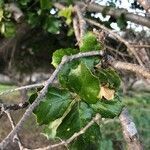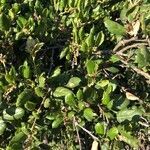Trees , evergreen, to 25 m. Bark gray to dark brown or black, ridges broad, rounded. Twigs brown to red-brown, 1.5-3 mm diam., with scattered pubescence or uniformly pubescent. Terminal buds light chestnut brown, ovoid, occasionally subconic, 3-6(-7) mm, glabrous except for cilia along scale margins. Leaves: petiole 4-15(-18) mm, sparsely to densely pubescent. Leaf blade broadly elliptic to ovate or oblong, 15-75 × 10-40 mm, base rounded or cordate, margins entire or spinose, with up to 24 awns, apex blunt to attenuate; surfaces abaxially glabrous or with small axillary tufts of tomentum, veins raised, adaxially distinctly convex, rugose, glabrous, occasionally densely uniformly pubescent. Acorns annual; cup turbinate to cup-or bowl-shaped, rarely saucer-shaped, 9-13 mm high × 9-15 mm wide, covering 1/4-1/3(-1/2) nut, outer surface glabrous to sparsely puberulent, inner surface pubescent on innermost 1/3 to uniformly pubescent, scales acute, tips loose; nut ovoid to oblong or conic, 15-35 × 10-15 mm, glabrous, scar diam. 3.5-8 mm. 2 n = 24.
More
An evergreen tree. It grows 12 m high and spreads 10 m wide. It has branches almost to the ground. The bark is smooth and black. It becomes rough with age. The leaves are oval or round. They have a hard texture and teeth with spines along the edge. The fruit are acorns which are half enclosed in the cup.
A dominant tree, forming open groves of great extent in valleys and on not too dry slopes in woods; also co-dominant in walnut woodland and mixed evergreen forest; and found as a shrub on coastal sand dunes; at elevations to 1,500 metres.
More
It is a warm temperate plant. It suits hardiness zones 8-10.




